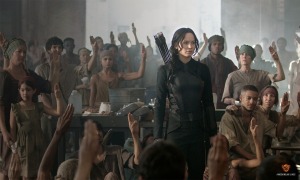Mockingjay Soars to Unexpected Heights
by Matthew Cabe
Initially, part of what kept me interested in Suzanne Collins’s The Hunger Games—the first book in a three-part series—was disbelief. Because it’s ostensibly a series for children (young adults, really), I carried strong doubts into the proceedings when it came to the possibility of anything really bad happening to 24 child (some younger than ten) tributes selected at random to fight to the death in a grisly show of allegiance to the powerful and rich Capitol of Panem. I naively expected the uprising to occur right before the Games began.
I was wrong, of course. Not one but two Hunger Games transpire between the first book and the second, Catching Fire. The uprising I expected didn’t begin in earnest until part-way through the final book, Mockingjay. By then, countless citizens (not just tributes) have been murdered. The Capitol’s President Snow proves quicker to commit acts of genocide than he does to blink. Lives and Districts lie in ruin.
The situation is as bleak and frightening as a young adult series can get, and the first cinematic installment of a two part finale, Mockingjay—Part I, captures that bleakness perfectly. The film is directed by Francis Lawrence, who wet his feet in the series by directing the film’s predecessor, The Hunger Games: Catching Fire, but nothing in the second film (or in the first, for that matter) will prepare viewers for what Lawrence accomplishes here.
Mockingjay is a stark, muted visual affair. Even the usually outlandishly-colored Capitol and it’s overtly wealthy citizenry are suppressed to match the dark mood, and a sense of grave urgency is what results. After all, tensions between the Capitol and its 12 Districts have reached their boiling points in the wake of Katniss Everdeen’s unprecedented survival in two straight Games.
Katniss, played with ever-increasing depth and complexity by the talented Jennifer Lawrence, unwittingly, then reluctantly, becomes the symbol of revolution among the Districts after she is rescued from the second Games (also called the Quarter Quell) by operatives from District 13, which was previously thought to be completely destroyed by Capitol bombs.
No longer is Katniss “The Girl on Fire” that viewers of the first Games became enraptured with. In Mockingjay she is more like “The Girl in Conflict”, and Lawrence balances her grief and resiliency remarkably well. Like the film’s visual style, Katniss is also muted. Her hair is a long, stringy mess. Her face is pale and unglamorous. Her attire resembles that of a federal penitentiary inmate.
The drab exterior parallels her emotional state, which is a mixture of exhaustion, fear and confusion. But there is also a spark of hope in her character that slowly reveals itself in subtle moments, one of which involves an intimate discussion between Katniss and her younger sister Prim (Willow Shields), who clues the stubborn heroine into the reaches of her possible power. All the while, Katniss is photographed by Jo Willems (the film’s cinematographer) to resemble Panem’s version of Joan of Arc.
After the conversation with her sister, Katniss finally agrees to be the symbol of revolution, and is placed in harm’s way in order to create convincing propaganda pieces that will hopefully incite her fellow rebels. A running theme in the books is that Katniss is a terrible actress, that she can’t come across as genuine unless left to her own devices in instances of dire reality. The theme is cleverly played up in the film and allows Lawrence chances to show off the range of her acting abilities, which unlike Katniss’s, are boundless.
Lawrence isn’t alone here though. Mockingjay is rounded out by a star-studded supporting cast of actors from Julianne Moore to Woody Harrelson to the late Philip Seymour Hoffman (the film is rightly dedicated to his memory) working at or near the top of their games as well. The standout among them is Elizabeth Banks as Effie Trinket, the fashion-savvy, Capitol-born chaperone who unintentionally becomes part of the rebellion when she agrees to dress Katniss up for the propaganda pieces. Like the film itself, Effie’s lavish brightness is stripped away, and Banks uses the opportunity to effectively humanize her character and provide a slew of witty one-liners that lighten the mood ever so slightly.
For a film being marketed mostly to kids, Mockingjay is surprisingly socially aware. In part, it’s a serious film that asks very difficult questions regarding morality, love, war and death, and is comfortable with leaving the questions unanswered; there is a second film coming in 2015, after all. It’s also an adept action film. The battle sequence in District 8 is as tense and graphic as anything in the current action genre.
What’s even better though is how the film ruminates on the consequences of that “action”. Because there are even more scenes that showcase the haunting aftermath of battle and the casualties of war. A shot of the firebombed District 12 is especially unnerving in that it depicts the victims in a way similar to what you’d see upon visiting the ruins of Pompeii.
My only qualm with Mockingjay is that the film lacks patience. There are numerous inspired shots throughout it’s 123 minutes, and they’re gone before you get a chance to fully savor the mastery required to stage them. It’s a film too intent on focusing on it’s main character, but with an actress like Jennifer Lawrence portraying her, you can’t really blame the filmmaking team for keeping her at the center of everything.

